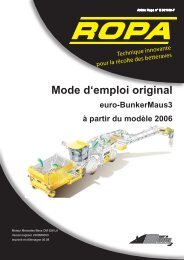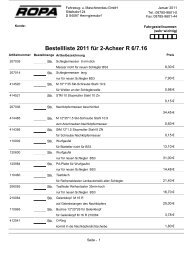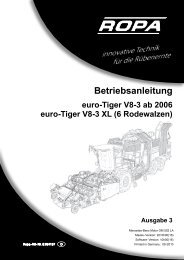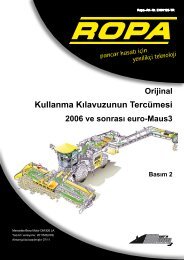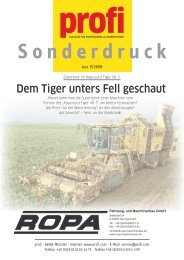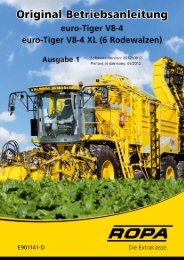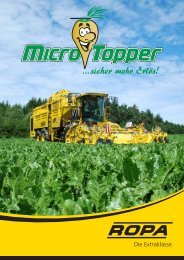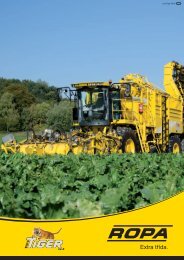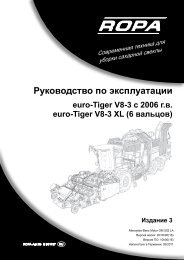Original Operating Manual - ROPA Fahrzeug
Original Operating Manual - ROPA Fahrzeug
Original Operating Manual - ROPA Fahrzeug
Create successful ePaper yourself
Turn your PDF publications into a flip-book with our unique Google optimized e-Paper software.
9 Schedules and Tables/Plans and Diagrams/Maintenance Slips<br />
9.9.4 AdBlue ® information sheet<br />
AH14.40-N-0001-01A Information regarding usage,<br />
material properties and handling<br />
of AdBlue<br />
Definition<br />
AdBlue is the trade name for the diesel engine NOx reducing<br />
agent AUS32 with the norm designation DIN 70070.<br />
Objectives of AdBlue<br />
AdBlue is used to reduce poisonous nitrogen oxides to water vapor<br />
and elementary nitrogen in the exhaust gas of diesel-powered<br />
vehicles equipped with BlueTec technology.<br />
Chemical characterization and composition of AdBlue<br />
AdBlue consists of chemically pure urea, without addition of<br />
foreign substances, dissolved in demineralized water. The urea<br />
content amounts to 32.5 %. AdBlue is not an additive, but rather<br />
is supplied separately from an additional tank provided for this<br />
purpose on BlueTec technology-outfitted vehicles.<br />
Chemical formula: H2N-CO-NH2<br />
Molar mass (urea): 60.06 g/mol<br />
CAS (Chemical Abstracts Service) No.: 57-13-6<br />
------------------------------------------------------------------<br />
Handling of fuel and lubricants contaminated by AdBlue<br />
It is important to always ensure that AdBlue is kept separate from<br />
fuels, lubricants and other process materials, such as coolant, engine<br />
oil, gear/transmission oil, fuels, hydraulic fluid and brake fluid,<br />
and that the same containers and catch pans are not used. Even<br />
the tiniest amounts of AdBlue in the coolant circuit are enough to<br />
damage thermostats and temperature sensors. Process materials<br />
that contain traces of AdBlue must not be used further.<br />
Handling of AdBlue contaminated by foreign substances<br />
Individual components of the BlueTec SCR system react very<br />
sensitively to even the smallest traces of impurities in AdBlue.<br />
Therefore when handling AdBlue, it is always necessary to only<br />
use clean containers and catch pans that are dedicated for this<br />
purpose. AdBlue that contain traces of impurities must not be used<br />
further.<br />
------------------------------------------------------------------<br />
Usage period and storage life<br />
During storage, AdBlue decomposes into ammonium hydroxide<br />
and carbon dioxide and thereby no longer meets the requirements<br />
of the DIN 70070 standard.<br />
If the recommended storage temperature of maximum 25°C is<br />
maintained, then AdBlue meets the requirements of this norm for<br />
at least 6 months after its date of manufacture. If the recommended<br />
storage temperature is exceeded, then this period is shortened.<br />
AdBlue freezes and solidifies at temperatures below -11°C.<br />
If warmed, frozen AdBlue will again liquefy and can be used again<br />
without degradation of quality.<br />
Refer to the Mercedes-Benz Specifications for <strong>Operating</strong> Fluids<br />
(MB BeVo) for information regarding the maximum permitted<br />
usage period of AdBlue.<br />
Disposal and degradability<br />
AdBlue only poses a low level of danger to water bodies and soil.<br />
It can be further used by microbes and is therefore easily decomposed.<br />
Due to this reason, AdBlue is classified in Germany in the<br />
lowest risk category of water-hazards WGK 1 (German Water<br />
Hazard Classification).<br />
------------------------------------------------------------------<br />
Chapter 9<br />
Schedules and Tables/Plans and Diagrams/<br />
Maintenance Slips<br />
406<br />
All engines<br />
Marking<br />
Supply pumps for dispensing AdBlue are to be marked with norm<br />
designation DIN 70070 and/or the trade name AdBlue.<br />
Physical and chemical properties of AdBlue<br />
State: liquid<br />
Color: colorless, clear, light yellow<br />
Odor: slight ammonia odor<br />
pH value: 10 (aqueous solution, 10 %)<br />
Crystallization initiation: -11°C<br />
Boiling point/Boiling range: 103°C<br />
Flash point: -<br />
Self-ignition temperature: not self-igniting<br />
Density: approx. 1.09 g/cm3 at 20°C<br />
Viscosity, dynamic: approx. 1.4 mPas at 25°C<br />
------------------------------------------------------------------<br />
Protection of electrical and electronic components when<br />
handling AdBlue<br />
AdBlue leads to corrosion of electrical and electronic components.<br />
Due to this reason, all electrical and electronic components in<br />
the vicinity must be covered to avoid contact with AdBlue during<br />
performance of any tasks in which AdBlue could leak out.<br />
Storage and packaging<br />
In order to avoid crystal precipitation, it is recommended that Ad-<br />
Blue be stored under normal conditions (optimally at up to 25°C).<br />
In order to avoid negative effects upon the quality due to contamination,<br />
AdBlue should only be handled via storage and filling<br />
systems designed for such purposes. Suitable container materials<br />
include alloyed steel, aluminum, various plastics as well as plasticcoated<br />
metal containers.<br />
Not suited for this purpose are unalloyed steels, copper, coppercontaining<br />
alloys and zinc-plated steels.<br />
------------------------------------------------------------------<br />
Disposal of smaller quantities:<br />
Due to its easy decomposition, small quantities of spilled AdBlue<br />
can be rinsed away without a problem using copious water.<br />
Disposal of larger quantities:<br />
Disposal of larger quantities of AdBlue must be carried out in compliance<br />
with applicable recovery and disposal regulations.<br />
The applicable waste treatment classification is location-dependent<br />
and is to be carried out in accordance with the European<br />
Waste Catalog (EWC) and/or the German Directive on the List of<br />
Waste Materials (AAV).<br />
Contaminated packaging:<br />
Packaging on which remnants of AdBlue adhere is to be treated as<br />
the substance itself. It is best to empty packaging, clean appropriately<br />
and then introduce into the appropriate recycling waste<br />
channel.<br />
------------------------------------------------------------------<br />
Regulations<br />
The product does not need to be labeled in accordance with EC directives or respective national laws.<br />
National regulations:<br />
Statutory Ordinance on Hazardous Incidents: not subject to<br />
German Water Hazard Classification: WGK 1, slightly hazardous to water in accordance with German Administrative Regulation Regarding<br />
Water Pollutants (VwVwS)<br />
© Daimler AG, 14 Sept. 2010, G/09/10, ah14.40-n-0001-01a, Information regarding usage, material properties and handling of AdBlue



